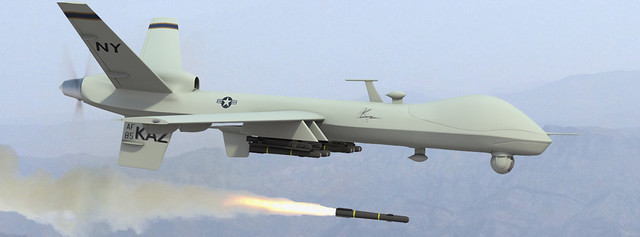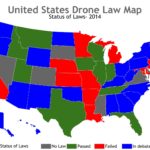by Connor Nelson, Anna Neibling, and Max Stocking
Source: KAZ Vorpal via Flicker.com
Drone Strike in Yemen Said to Kill Senior Quaeda Figure – 5 Feb 2015
Al Qaeda announced on Thursday that a United States drone strike in Yemen killed four members of the group, including a senior member named Harith al-Nadhari. Harith al-Nadhari was a member of the group’s Shariah Committee, and had been vocal in his support of the recent attacks on the Paris newspaper Charlie Hebdo. Mr. Nadhari claimed the attacks were justified revenge against the French for insulting the Prophet Muhammad. Even though the Houthi group in de facto control of Yemen does not support United States drone strikes within Yemen, they have taken no action to protest the five strikes Al Qaeda claims have occurred since they took control.
Why The U.S. Government is Terrified of Hobbyist Drones – 5 Feb 2015
In response to the dramatic “drone at the White House” incident weeks ago, the China-based drone manufacturing company, DJI, who made the drone used by the man at the White House, has pushed a “mandatory firmware update” for its Phantom 2 drones that would prevent the drone from flying within a 15.5 mile radius of the White House. This technology is known as GPS geofencing. In effect, as drones fly get near and enter no-fly zones their max altitude tapers off until they land and refuse to take off again, until carried out of the no-fly zones. No-fly zones include airports and government buildings, which sometimes encroach on publicly or even privately owned land. The government argues that geofencing will stop future terrorists attacks by enemy drones. Critics and hobbyists purport that it infringes upon their rights as citizens and won’t possibly be able to counter terrorists’ attacks.
To Catch A Drone: Governments Seek Ways to Counter Tiny Fliers – 4 Feb 2015
Given the recent rise in popularity of civilian drones, governments are seeking ways in which to counter emerging threats created by their use. In France, sightings of drones near nuclear power plants and other sensitive locations are on the rise, while in the United States, a DJI Phantom crashed on the White House lawn in the early morning hours of Jan 26th. Risks posed by drones include threats to privacy, theft of national or corporate secrets, or use in terrorist acts. In light of these fears, governments are seeking ways to counter all of these threats. The French government currently is overseeing an initiative for private to invent new anti-drone technology. Other solutions that have already been tested include a Chinese laser weapon designed to shoot down hostile drones and a French drone designed to intercept and capture rouge drones.
A Swarm of Drones that Just Wants to Help – 4 Feb 2015
A group of MIT researchers has designed and programed a group of five drones to coordinate with each other in a manner similar to insects. In concept, the five drones would fly over bodies of water, searching for environmental abnormalities such as cyanobacteria using cameras. If they detect an abnormality, one of them will swoop down and collect a water sample. This project is one of 19 semifinalists in the UAE competition “Drones for Good”, which seeks to reduce the stigma on drones by encouraging development of socially beneficial uses for drones. Other semifinalists include drones for transporting organs, detecting fire risks in parks, and bringing emergency supplies to people who are stranded.
Americans OK With Police Drones – Private Ownership, Not So Much – 4 Feb 2015
In a recent Reuters/Ipsos online poll, 42% of respondents oppose private ownership of drones while 68% support drone use in law enforcement. Meanwhile, 46% don’t want news organizations using drones to gather news and 64% said they would not want their neighbor to have a drone. These among other stats culminate with the fact that 73% of respondents want regulations for lightweight drones used commonly by hobbyists as of late. As the commercial and social use for drones increases, how will the public’s demand for regulations come to fruition? Will society be able to accept, even integrate, drones into their daily lives?
Montana Lawmaker Wants to Keep Drones from Harassing Hunters – 3 Feb 2015
A Montana legislator has proposed a bill which would ban drones from harassing people while they are hunting or fishing, including photographing people while hunting or fishing in public and flying above waterways during fishing season. Harassment of hunters or fishermen under this bill would result in a fine between $300 and $1000, and up to six months in prison. Republican Representative Jeff Essmann wrote the bill after being contacted by one of his constituents, who claims to have been harassed by a drone while fishing with his brothers in the Boulder River two years ago. John MacDonald, representing the Montana Newspaper Association, claims the bill would infringe upon First Amendment rights by prohibiting photography in public places.
Chinese Drone Maker DJI Tackles Security Fears Amid Booming Market – 2 Feb 2015
Leading Chinese drone manufacturer DJI announced that it has rolled out software that establishes “no fly” zones. The software update comes as a response to growing security concerns escalated by the crash of a DJI Phantom drone on the White House lawn on Jan 26th. DJI has already installed programing identifying “no fly” zones around airports and is working with regulators from the FAA and elsewhere to establish clear boundaries on other locations in response to concerns about threats to aircraft safety, civilian privacy, and terrorism. The platform DJI delivers with its quadcopter drones has created impressive demand with civilian hobbyists and various industries.



